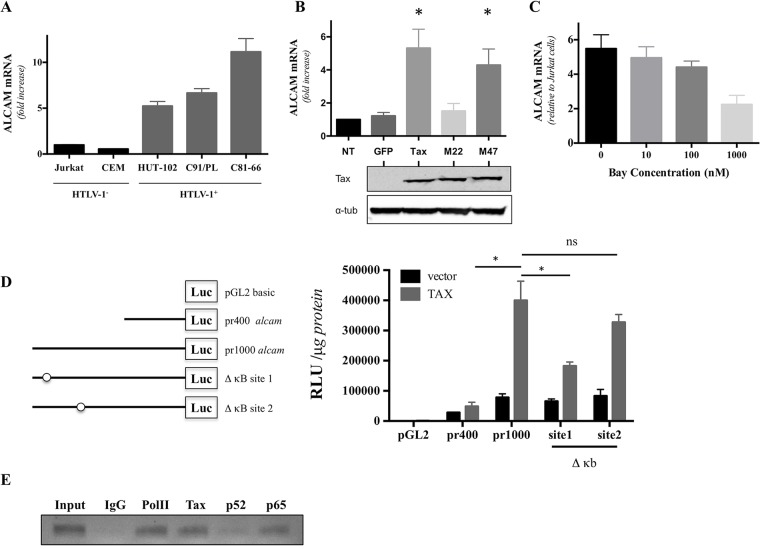FIG 3.
The canonical NF-κB pathway upregulates alcam expression via Tax transactivation. (A) alcam expression is higher in cells chronically infected with HTLV-1. alcam mRNA levels were assessed by RT-qPCR in uninfected (Jurkat and CEM) or infected (HUT-102, C91/PL, and C81-66) lymphocytes. The data were normalized to GAPDH expression and Jurkat cells. The graph presents means ± SDs from four independent experiments. (B) alcam is overexpressed in Jurkat cells upon transduction with Tax proteins competent for NF-κB activation. alcam mRNA levels were assessed by RT-qPCR on Jurkat cells transduced with lentiviral vectors encoding GFP or Tax (WT or mutants M22 and M47)-IRES-GFP. The data were normalized to GAPDH expression and nontransduced (NT) Jurkat cells. Theraph represents means ± SDs from four independent experiments. *, significance (P < 10−4, Friedman test, Dunn's post hoc test). (C) NF-κB inhibition reduced alcam mRNA levels. Jurkat and C91/PL cells were cultured with different concentrations of Bay 11-7082. alcam mRNA levels were assessed by RT-qPCR after 24 h of treatment. The graph presents means ± SEMs of ALCAM mRNA from three independent experiments. (D) The κB site 1 (at position −962) is involved in Tax-mediated alcam transactivation. 293T cells were transfected with pGL2-basic vectors encoding luciferase under the control of the alcam promoter (either a 400-bp (pr400) or a 1,000-bp (pr1000) segment, or the pr1000 lacking a κB site: site 1 or site 2), together with the pSG5M or pSG5M-Tax plasmids. Luciferase activity (relative light units [RLU]) was normalized to the protein concentration. The graph presents the means ± SEMs from three independent experiments. *, significance (P < 10−4, two-way ANOVA, Sidak's post hoc test). ns, not significant. (E) Tax directly recruits the canonical NF-κB complex to the alcam promoter. A ChIP assay was performed on C81-66 cells using IgG control, anti-RNA PolII (noted PolII, as a positive control), anti-Tax, anti-p52, and anti-p65 antibodies. A 140-bp DNA fragment corresponding to the alcam promoter was revealed on an agarose gel. The results are representative of those from three experiments.

